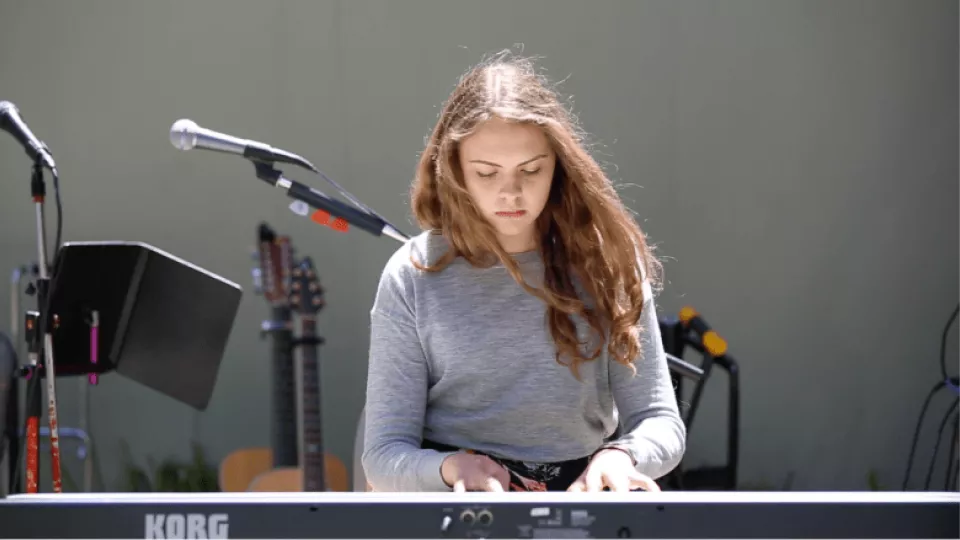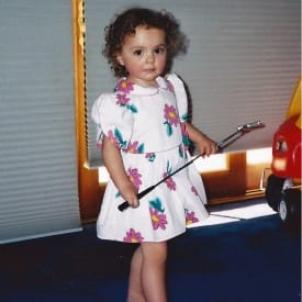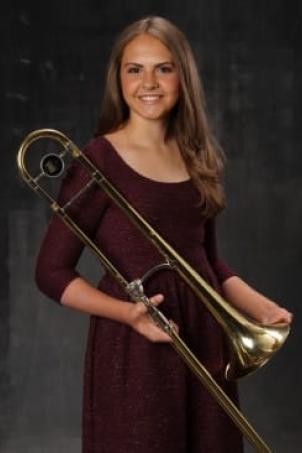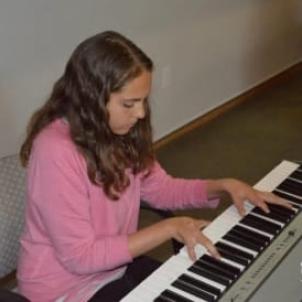
Emily’s Gift
Karen Hayhurst was giving her daughter Emily a piano lesson one day when Emily, then 7, piped up with a question.
“Wouldn’t this be a lot easier,” she reasoned, “if I had five fingers on each of my hands?”

Her mother’s response was matter-of-fact. “I told her, ‘Probably, but then how are you going to do it?’” Karen remembers. “And she said, ‘I think I’ll do it like this!’”
Emily, now almost 18, was born with two cleft hands, a rare condition that left her with just seven fingers—three on her right hand and four on her left. The configuration of her fingers at birth would have left her severely limited. However, thanks to a series of surgeries at Children’s Hospital Los Angeles, Emily is anything but limited.
She’s not only a straight-A student who will be studying communications at Allegheny College in the fall, but she’s also a talented pianist, plays the trombone and was drum major for her high school marching band this past year.
“I’ve gotten to the point,” says her dad, John, “where I totally forget about her missing fingers.”
‘I had a lot of fears’
When Emily was born, her parents weren’t sure what kind of life she would have.
“I had a lot of fears,” John admits. “Is she going to get taunted at school? What’s it going to be like for her?”

She underwent her first surgery at CHLA when she was 6 months old. During that surgery and subsequent ones, orthopedic surgeon and hand specialist Milan Stevanovic, MD, carefully separated Emily’s thumb and index finger, which were too close together on her left hand. He also performed two surgeries on her right hand. In all, Emily has had six surgeries on her hands.
“Basically, I arranged her fingers on both hands into more functional positions,” he explains. “It’s very important for these kids to have corrective surgery early in life so they can get the best results.”
The surgeries dramatically improved Emily’s hand function. Still, few parents probably would have thought of teaching her to play the piano. But the Hayhursts are a musical family—John is a violist for the Los Angeles Philharmonic, and Karen was a professional flutist who has performed with the L.A. Philharmonic and now teaches music. When Emily was 4, Karen began giving her piano lessons.
“The first few piano books have the fingerings written on the notes for you,” Emily explains. “So my mom and I would go through and just change those fingerings. I wasn’t learning anything more difficult. I just had to learn it differently.”
And though she sometimes had to deal with rude stares and insensitive comments, her father’s fears proved unfounded.
“Most people don’t ask me about my hands,” she says. “If they do, they’re really nice about it. I tell them, ‘Oh, I was just born like that,’ and they’re like, ‘Oh, OK.’ It’s pretty easy to deal with.”
Inspiring others
Emily’s dad speaks with pride about his daughter’s “beautiful touch” on the piano. But music is hardly her only talent.
“From a young age, she just had such a great personality,” John says. “She’s always been strong; she’s always been good with people. I think that was her gift.”

Emily’s confidence and leadership skills have turned her into a role model for other kids with hand anomalies. She is part of CHLA’s CATCH (Center for Achievement of Teens and Children with Hand Differences) program, which hosts an annual picnic attended by more than 250 patients and families.
“I love CATCH,” says Emily, who has played piano at the picnics. “I love the sense of community and safety it brings. Kids can come and see that they don’t have to worry about not accomplishing things or not fitting in.”
The program was created eight years ago by Nina Lightdale-Miric, MD, director of the Pediatric Hand and Upper Extremity Surgery Program at CHLA. This year’s event featured retired Major League Baseball pitcher Jim Abbott, who was born without a right hand, as one of the speakers.
“CATCH grew out of my waiting room, where I saw families talking to each other and trying to connect,” Lightdale-Miric explains. “I wanted to provide an open and welcoming community for them, where they could get to know each other, learn from each other and support each other.”
Emily’s advice to other young people with hand differences? As with those first piano lessons, it’s about finding ways to adapt.
“You start with the smaller things, and you work your way up and overcome bigger obstacles,” she says. “You just have to take it one step at a time.”



